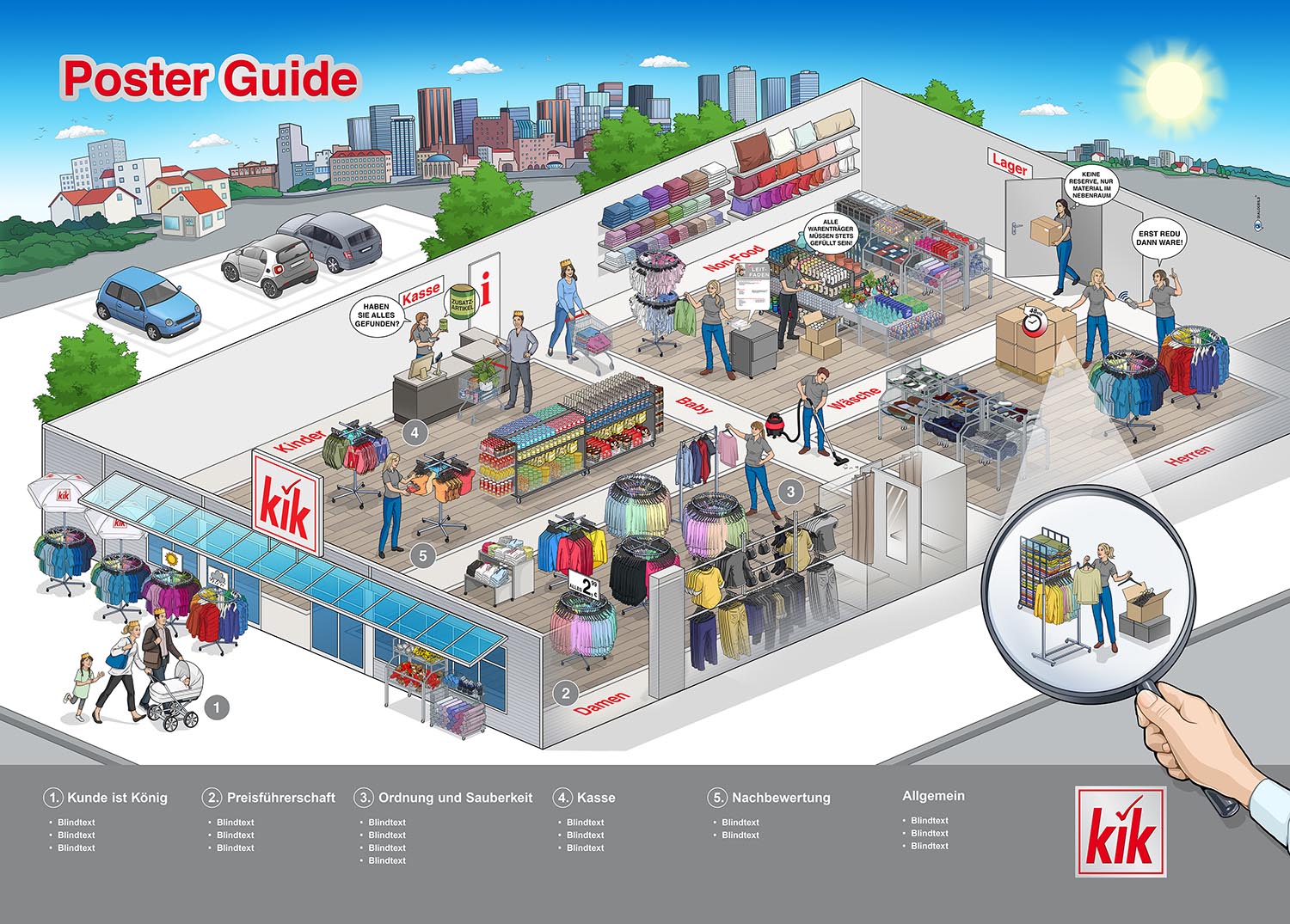







Employee training - What you should pay attention to
In this guide you will learn what you should pay attention to when planning and implementing employee training. This also includes special requirements such as employee data protection training and developing a successful training concept. We will also show you how Dialogbild as an agency can visually support your training measures.
Why is employee training important?
Well-conducted employee training offers numerous advantages:
1. Transfer of knowledge: Training helps to impart specialist knowledge, new methods and processes, which increases the efficiency and competence of employees.
2. Motivation and commitment: Employees feel valued and motivated when they receive regular training opportunities. This strengthens their loyalty to the company.
3. Regulatory requirements: In many industries, training, especially in the area of data protection, is mandatory in order to comply with legal regulations.
4. Long-term success: Companies that continually invest in employee training promote the professional and personal development of their workforce and remain competitive.
Planning Training: A Checklist for Success
Before conducting any training, it is important to plan it carefully. Here is a checklist to help you organize an effective training session:
1. Define goals
Before you start planning, you should set clear goals. What is the training intended to achieve? Is it to teach specific skills or cover legal requirements such as data protection? The goals help to define the training content and measure success.
2. Analyze your target group
Who should attend the training? Different departments and employees have different requirements. It is important to adapt the content to the specific needs of the target group in order to maximize relevance and learning success.
3. Determine training methods
Consider which method works best for your target audience. Options include:
- Classroom Training: Particularly useful for interactive training that includes hands-on training.
- Online training: Ideal for large groups or decentralized teams as they can be carried out flexibly and regardless of location.
- Blended learning: A mix of face-to-face and online training offers flexibility and interactivity.
4. Create training content
The content of the training should be clearly structured and aligned with the learning objectives. For example, training in the area of data protection should comprehensively cover current legal regulations, such as the GDPR. Use examples to make what you have learned practically applicable.
5. Prepare materials and resources
Make sure all necessary materials and tools are ready before the training. This includes presentations, handouts, technical equipment or online platforms. Data protection training often requires specific documents and checklists.
6. Set training dates and rooms
Set training dates well in advance and ensure that the premises or technical requirements (for online training) are organized. Keep in mind the availability of participants and possible technical challenges.
7. Obtain and evaluate feedback
After the training, it is important to get feedback from the participants. Which content was well understood? Where are there still questions? The feedback helps to improve and optimize future training.
Employee training in the area of data protection
One of the most important issues in modern companies is data protection. Data protection training is not only required by law, but also crucial to protect the company from data breaches and legal consequences.
Why is data protection training important?
Data protection violations can result in high fines and reputational damage for companies. Regular employee data protection training ensures that all employees know the applicable regulations and how to properly handle sensitive data. The training must be designed in such a way that all employees – regardless of their department – understand the importance and effects of data protection.
Contents of a data protection training
Data protection training should cover the following points:
- GDPR Basics: The key principles and rights enshrined in the General Data Protection Regulation (GDPR).
- Responsibilities in the company: Who is responsible for data protection and what obligations do employees have?
- Handling of personal data: Proper collection, processing, storage and deletion of data.
- Data breaches: What are common mistakes and how can they be avoided?
- Reporting obligations and sanctions: What happens if violations occur and how can fines be avoided?
Developing a training concept - how to proceed
A good training concept is the key to successful employee training. It helps to structure the training and ensure that all relevant topics are covered. How to develop a training concept:
1. Define goals and content: Think about what the participants should learn. Then create the content and modules that convey this knowledge.
2. Determine training methods: Choose the best method (face-to-face, online, blended learning) for your target group and the content.
3. Create a schedule: Create a detailed schedule that takes into account the order of topics as well as breaks and final discussions.
4. Plan resources: Plan the necessary resources and materials needed for the training.
5. Include evaluation: Add elements to evaluate training success, such as quizzes or hands-on exercises to check student understanding.
Schulung planen Checkliste
A training planning checklist helps to ensure that nothing is forgotten and that all aspects of the training are well organized. Here are the most important points to consider when planning a training course:
- Determine the goals of the training
- Analyze target group
- Develop content and topics
- Choose training methods (face-to-face, online, blended learning)
- Prepare training materials
- Set training dates and rooms
- Ensure technical requirements (for online training)
- Obtain feedback and measure training success
How Dialogbild can help with employee training
Training is most effective when it is clear, understandable and visually appealing. Dialogbild is an agency that specializes in making complex content understandable through visual representations such as explanatory images and interactive training formats.
This is how Dialogbild supports your training:
- 1. Visual explanatory images: We create customized explanatory images that present complex training topics in an easy-to-understand way. This is particularly useful for topics such as data protection, where visual representations make understanding much easier.
- 2. Interactive training solutions: Our interactive training formats enable participants to actively engage with the training content and directly apply what they have learned.
- 3. Tailor-made training concepts: We develop individual training concepts that are tailored to the needs of your company and your employees.

OUR CULTOUR CHANGE
WHO WE ARE. HOW WE ARE. WHERE WE WANT TO BE.
AOK Rheinland-Pfalz/Saarland - The health insurance company is the largest health insurance company in the two federal states of Rhineland-Palatinate and Saarland, with over 1. 2 million insured persons and 85,000 supervised employers as well as around 3,500 employees. The health insurance fund maintains business relationships with more than 100 hospitals, 10,000 doctors, psychotherapists and dentists, around 1,300 pharmacies and many hundreds of other contract partners. It offers high-quality care for the population and tailor-made concepts in the regions. For this, modern, future-oriented structures are also essential in the corporate culture.
In the framework of the"Together on CulTOUR" programme, develops a vision of the future and principles for leadership and cooperation. The existing brand mission statement of the AOK-community was adapted. ...

FUTURE@DOMS
DIALOG FILM FOR THE CURRENT STATE AND COMING CHALLENGES
ROCHE Diagnostics, with its approximately 17,200 employees, looks after patients‘ wellbeing in Germany. They are the second largest country representative within the worldwide ROCHE group. The two business areas, pharmaceuticals and diagnostics, are represented across the entire value chain in Germany: from research and development, over production, logistics to marketing and distribution of innovative products. Next to the focus on the German market, all four locations include global functions. ROCHE Diagnostics has strong roots and always looks towards the future. Because of this, they constantly invest - in their German locations, in technologies and new solutions, in research and cooperation, in the environment and society and in their employees. ...

"CUSTOMER IS KING" POSTER GUIDE
STANDARDIZED PROCESSES & FIRMLY ESTABLISHED PRINCIPLES
KiK means "Kunde ist König" (engl. "customer is king") and is the guiding principle of the company, which since its foundation in 1994 has now successfully established itself with around 3,500 branches in eleven European countries. As one of the top ten companies in the textile discount sector, KiK is a real heavy weight in the German retail trade. More than 26,000 employees contribute to the annual branch growth of approximately 200 shops and the economic success of KiK. The long-term goal is to operate 5,000 stores in Europe with a modern design.
Standardized processes in the branches and firmly established principles are indispensable in this context. ...

MISSION STATEMENT: ATTRACTIVE EMPLOYER
THESE BENEFITS ARE OFFERED BY PLUSCARD AS AN EMPLOYER
"PLUSCARD is a service provider in the field of cards for savings banks and banks. More than 470 employees are responsible for over 6 million cards in the portfolio at three locations in Saarland.
Since the card business has been growing organically for many years, the questions for further services from PLUSCARD are also increasing. Furthermore, more and more transactions have to be processed and numerous legal regulations from the banking industry have to be implemented. This creates an ever-increasing need for new employees from various commercial and IT professions. ...

NEW FEATURES OF THE COMPANY AGREEMENT
DEVELOPMENT OF INDIVIDUAL SCENES
Adolf Würth GmbH & Co. KG is a market leader in Germany and employs over 7,400 people. Norbert Heckmann, Chairman of the Board of Management, on Würth's strategy: "We network sales channels. We solve technical challenges and meet each customer's individual needs. And we know that only constant further development, makes a company attractive for its customers." The company has evolved from a screw shop into the world's leading specialist for fastening and assembly materials and tools, with more than 125,000 different products. The goal: to make work easier for customers through individual services, practical system solutions and a broad product range. Würth works with more than 650,000 customers from the trades, construction and industry in Germany. ...

FIT FOR FUTURE
FIRST AID DRESSINGS
Leukoplast is a brand of Essity, a globally leading hygiene and healthcare company committed to improving the quality of life through high-quality hygiene and healthcare solutions. Essity sells its products and solutions in around 150 countries and employs around 46,000 people worldwide. Due to the new alignment of the First Aid Dressing portfolio, the company is facing many changes that have to be implemented in a short time and communicated to all employees. ...
Frequently Asked Questions
What is employee training?
Employee training is a structured program that aims to impart specialist knowledge, skills and behaviors to increase employee efficiency and competence. It helps employees adapt to new developments and contributes to achieving company goals.
Why is employee training important?
Employee training is important because it:
- Improves employee knowledge and skills.
- Promotes employee motivation and commitment.
- Helps companies meet legal requirements such as data protection.
- Secures the company’s long-term competitiveness.
What does data protection training include?
Data protection training teaches employees the basics of data protection, especially with regard to the General Data Protection Regulation (GDPR). Contents of a data protection training include:
- Handling of personal data
- Rights and obligations of employees
- Security measures to protect data
- Reporting obligations in the event of data protection violations
- Penalties for violating data protection regulations
What is a training concept and how do I create one?
A training concept is a plan that defines the goals, content, methods and time frame of a training course. To create a training concept, you should:
- Define goals that the training should achieve.
- Analyze the target group and their needs.
- Select suitable training methods (face-to-face, online, blended learning).
- Establish a schedule and the necessary resources.
- Plan measures to evaluate the success of the training.
How do I plan employee training?
Planning a training course requires a clear structure and organization. Use this checklist to plan your training:
- Define the goals of the training.
- Analyze the target group and their learning needs.
- Create training content that aligns with learning objectives.
- Choose appropriate methods (face-to-face training, online training).
- Prepare all necessary materials and supplies.
- Set deadlines and ensure that space or technical resources are available.
- Obtain feedback and measure training success.
How often should data protection training be carried out?
Data protection training should be carried out regularly, ideally once a year. In addition, new employees should be trained as part of onboarding. If there are changes in data protection regulations or internal guidelines, refresher training should also take place.
What training methods are there?
There are various training methods including:
- In-person training: On-site training with direct interaction.
- Online training: Digital training formats that can be carried out regardless of location.
- Blended Learning: A combination of face-to-face and online training that offers flexibility and interactivity.
Why is employee data protection training important?
Data protection training is important to ensure that employees understand the legal requirements of the GDPR and are able to handle personal data securely. Data protection training helps to avoid fines and ensure the trust of customers and partners.
How can Dialogbild help with employee training?
Dialogbild supports companies in the design and implementation of employee training by:
- Developing visual explanatory images that present complex training topics in an easy-to-understand manner.
- Offering interactive training solutions that enable employees to apply what they have learned in a practical way.
- Developing tailor-made training concepts tailored to the specific needs of your company.
What are the benefits of visual training materials?
Visual training materials such as those offered by Dialogbild have many advantages:
- They make it easier to understand complex content.
- They improve the participants' memory.
- They are appealing and encourage employee engagement.
- They can be used flexibly in face-to-face and online training.
 SELECT INFO PACKAGE
SELECT INFO PACKAGE